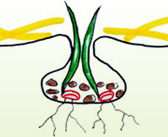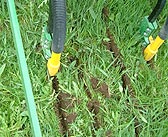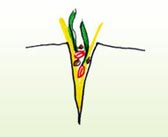The T-Slot
The shoe pushes aside all surface trash and prunes the roots of the existing sward when rejuvenating grassland. The chamber allows light and moisture to penetrate, but retains the warmth. Because the seed is surrounded by a fine tilth, root establishment is rapid.


Excellent germination + better root development = exceptional plant establishment
The V-Slot
 The seed is squeezed into a narrow compacted slot with less tilth created. The disc or discs are prone to hairpin the dying trash into the slot so it is in contact with the seed. Thus the toxicity created by the decaying vegetation can inhibit establishment.
The seed is squeezed into a narrow compacted slot with less tilth created. The disc or discs are prone to hairpin the dying trash into the slot so it is in contact with the seed. Thus the toxicity created by the decaying vegetation can inhibit establishment.
The slot made by a disc is not an ideal environment for either the germination or the root development of tender young seedlings.